Northern Cardinal
Cardinalis cardinalis
Males are a bright red color, also called "cardinal red"
Advertisement
Northern Cardinal Scientific Classification
- Kingdom
- Animalia
- Phylum
- Chordata
- Class
- Aves
- Order
- Passeriformes
- Family
- Cardinalidae
- Genus
- Cardinalis
- Scientific Name
- Cardinalis cardinalis
Read our Complete Guide to Classification of Animals.
Northern Cardinal Conservation Status
Northern Cardinal Facts
- Prey
- Small insects, worms
- Fun Fact
- Males are a bright red color, also called "cardinal red"
- Estimated Population Size
- Unknown
- Biggest Threat
- Insecticides, cats
- Most Distinctive Feature
- Raised crest
- Other Name(s)
- redbird, common cardinal
- Wingspan
- 9.8-12.2 inches
- Incubation Period
- 12-13 days
- Habitat
- Wetlands, shrublands, gardens, woodlands
- Predators
- Birds of prey, snakes, cats
- Diet
- Omnivore
- Type
- Passerine
- Common Name
- Cardinal, red cardinal
- Number Of Species
- 19
- Location
- North America and South America
- Nesting Location
- Trees, shrubs
- Age of Molting
- Unknown
View all of the Northern Cardinal images!
Males are a bright red color, also called “cardinal red”
The northern cardinal is a mid-sized songbird also called by its common names cardinal, red cardinal, common cardinal or redbird. It lives in North and South America. Introduced to Bermuda in 1700, it was also introduced to southern Arizona, southern California and Hawaii. The bird is one of many species of cardinal, so named for having the northernmost range, plus its cardinal-red color.
4 Incredible Northern Cardinal Facts!
- The term “redbird” refers to a cardinal, but “red bird” can mean any red-colored bird.
- The “cardinal” in both its common name and scientific name refers to the red caps and robes that Roman Catholic cardinals wear, also known as cardinal red.
- Male and female calls are sexually dimorphic due to hormonal differences.
- It’s called a northern cardinal to distinguish its range from other species.
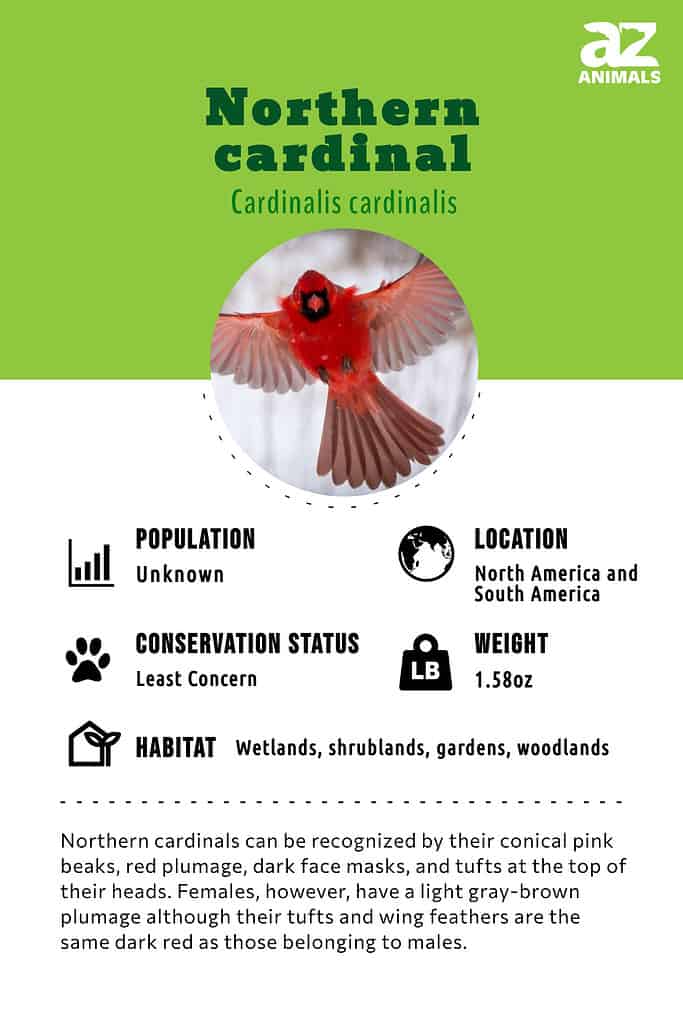
Where To Find Northern Cardinals
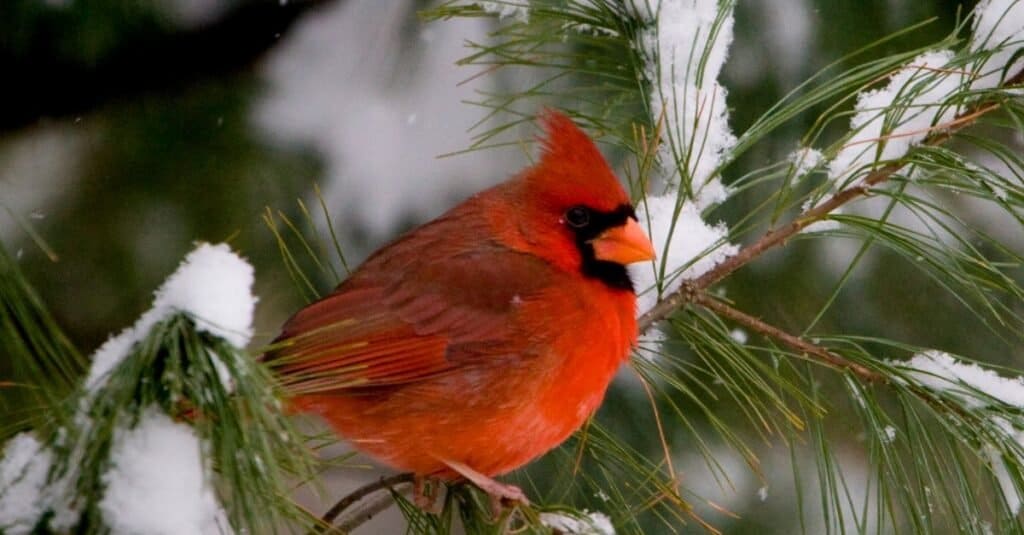
Both male and female North Cardinals co-operate in nest-building activities with the former providing the material and the latter, the skill
©iStock.com/BeyondMyLens
The natural habitat of the northern cardinal is wetlands, shrublands, gardens, and woodlands. You can find them in the southern half of Maine, Minnesota, the Texas-Mexico border, southern Canada, Mexico, northern Guatemala, northern Belize, Bermuda, Hawaii, southern California and southern Arizona. It nests in trees and shrubs. January through September is the mating season which is when people are most likely to see the bird.
Nests
The habitat of the redbird is dense shrubs and low trees about 3.3-9.8 feet off the ground. It is mostly the female who builds the nest, with the male providing nesting material. The nest has a cup shape and is made up of four layers being coarse twigs, sometimes with pieces of trash, grapevine bark lining, and then pine needles, rootlets, stems and grasses. It takes three to nine days to build, with the completed nest measuring 2-3 inches in height, 4 inches across, and an inner diameter of about 3 inches. The pair usually uses the nest only once.
Scientific Name
There are 14 genera in the family Cardinalidae, also known as cardinal-grosbeaks and cardinal-buntings. There are 3 species in the cardinal genus Cardinalis. 19 subspecies of Cardinalis cardinalis exist, with C. cardinalis being the type species.
Size & Appearance
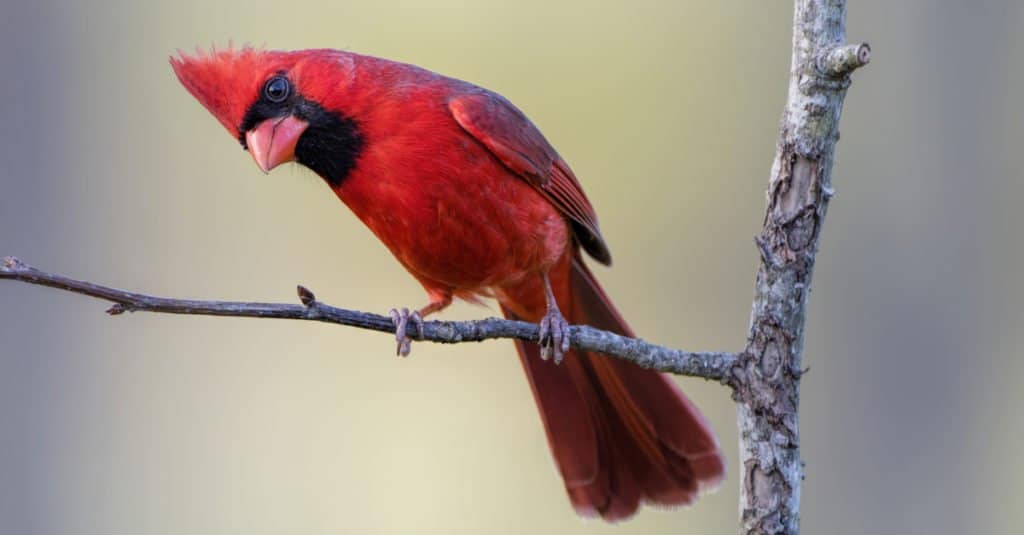
Northern Cardinals are not migratory by nature and molt from late summer to mid-fall
©Bonnie Taylor Barry/Shutterstock.com
The northern cardinal is a mid-sized songbird characterized by its raised crest and bright beak featuring a coral color. It measures 8.3-9.3 inches in body length with a wingspan of 9.8-12.2 inches. Males are a cardinal red color and females are olive-brown with red accents; males are also somewhat larger in length and weight than females. Adults weigh 1.19-2.29 ounces with an average weight of 1.58 ounces. Due to their bright color (whether the red body of the males or the coral color of both of their beaks) they conceal their nests in dense trees and shrubs.
They do not migrate and do not molt their plumage into a dull color. Instead, they lose a few feathers at a time from their bodies, and often lose all the feathers on their heads. Molting occurs during late summer through mid-autumn. Baby cardinals are born featherless with grey scaling and pink skin, and during molting get a tan color which changes to light, mottled browns, and soft reds before sexually dimorphic colors develop. Their beaks start off black and fade to a coral-red color.
Evolution
Northern cardinals’ close relatives include American sparrows and tanagers which belong to the Emberizoidea superfamily just like they do. These birds come under the wider umbrella of the suborder Passeri and as a result, are Passeriformes. Hence, they are also related to New Zealand wrens, which belong to the suborder Acanthisitti, and manakins which belong to the suborder, Tyranni.
The suborder northern cardinals form a part of has the most numerous of the three groups, containing 5,158 species. The Tyranni comes next with a total of 1,356 species. The Acanthisitti has the fewest with no more than 4 species. According to paleontologists, Passeriforms first came into existence about 50 million years ago during the early Eocene.
The Acanthisitti diverged first of all while the divergence of the Passeri and the Tyranni occurred afterwards.
Types
There are 19 subspecies of northern cardinal including:
- C. c. affinis
- C. c. canicaudus
- C. c. cardinalis
- C. c. carneus
- C. c. clintoni
- C. c. coccineus
- C. c. flammiger
- C. c. floridanus
- C. c. igneus
- C. c. littoralis
- C. c. magnirostris
- C. c. mariae
- C. c. phillipsi
- C. c. saturatus
- C. c. seftoni
- C. c. sinaloensis
- C. c. superbus
- C. c. townsendi
- C. c. yucatanicus
Behavior
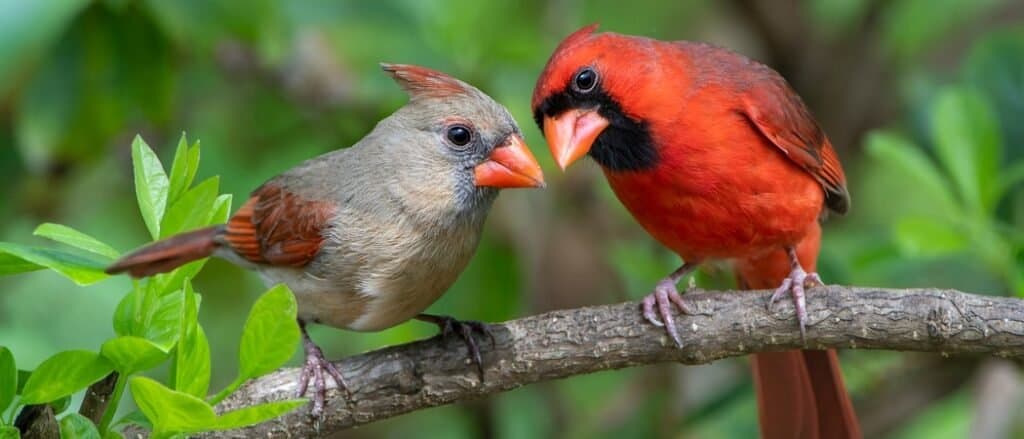
Both male and female northern cardinals differ in terms of the color of their plumage
©Bonnie Taylor Barry/Shutterstock.com
The calls of males and females are sexually dimorphic due to hormonal differences. However, they are indistinguishable to the human ear. Northern cardinals have a variety of songs. Males are territorial, and one of their calls is a clear, high whistle from high up in a tree to defend their territory. Both sexes learn their songs and so their songs vary depending on their area. Their songs consist of clear whistles in repeating patterns at first which then become varied. They also make metallic, short chip sounds as warning calls against predators or for a pair to locate each other. When not mating, northern cardinals rejoin their flock.
Diet

The northern cardinal’s typical food consists of grains, seeds, fruit, and insects. Insects include grasses, grains, tree buds, nuts, cutworms, caterpillars, grasshoppers, termites, spiders, and beetles, which it digs from the ground and bushes with its strong beak. Insecticides and other chemicals are toxic to them. For a complete list of the foods cardinals eat, check out our “What Do Cardinals Eat?” page.
Predators and Threats
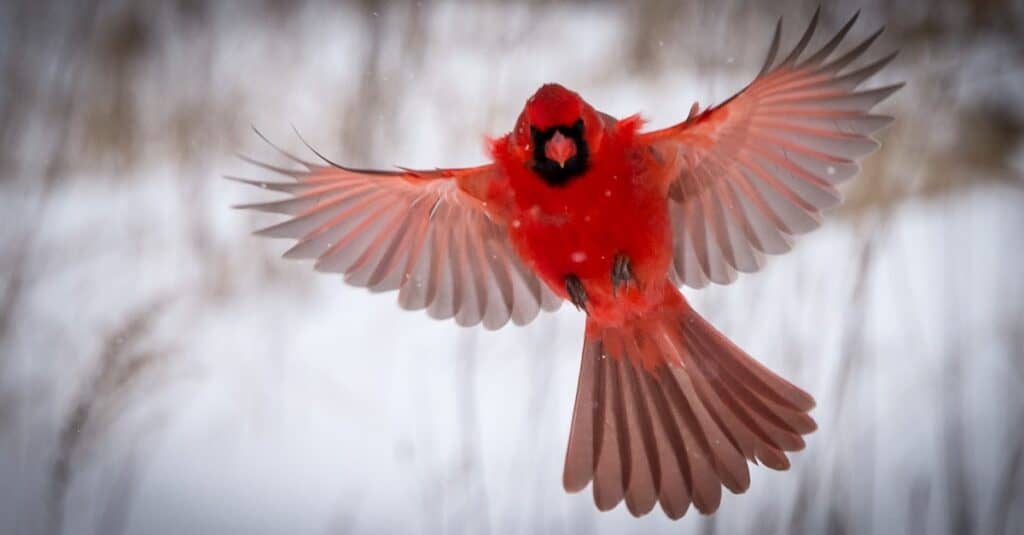
Northern cardinals’ bright plumage makes them rather conspicuous to predators such as eagles, falcons, hawks, and owls
©iStock.com/Lynnae_Lowe
Because the northern cardinal looks for food on the ground, and it has bright colors, other animals can easily see it. The search for food leaves it vulnerable to predators, especially birds of prey like eagles and owls, and even moreso during the winter in contrast with snow. Other birds of prey that hunt northern cardinals are hawks, falcons, and shrikes. Snakes and domestic cats also hunt them. Even squirrels and chipmunks can kill them, as can crashing into windows. Predators of eggs and chicks are domestic cats, chipmunks, squirrels, crows, blue jays, and snakes.
Reproduction, Babies, and Lifespan
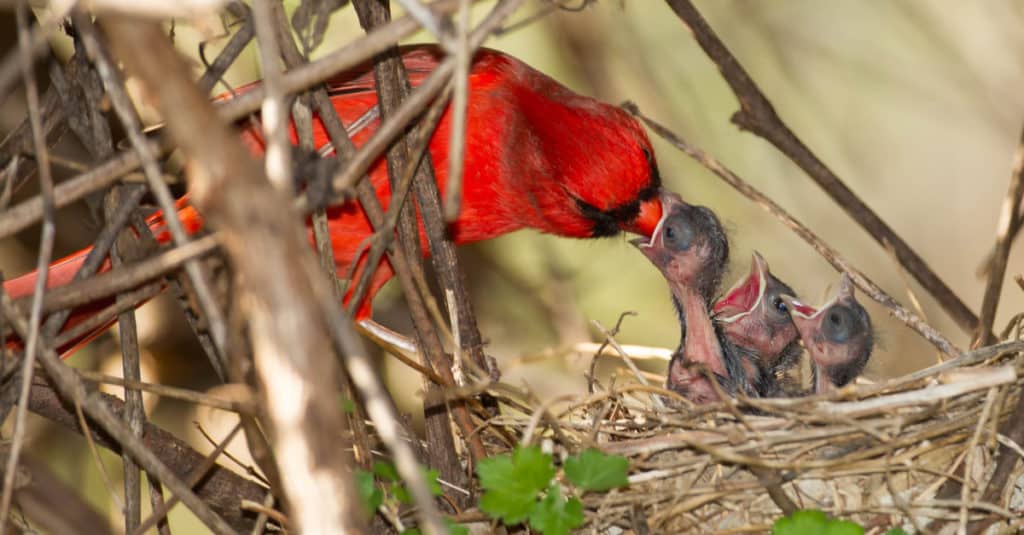
Northern cardinals both care for their eggs and their young with males responsible for feeding hatchlings
©Agnieszka Bacal/Shutterstock.com
Mating season for northern cardinals begins as early as January and ends as late as September. They usually mate for life, although they may have other mates between seasons, and when their mate dies, they find another one. Males feed females in order to bond with them, and also provide nesting materials. They sing together before nesting.
Females lay eggs one to six days after completing the nest, with a clutch size of three or four eggs each time and two to four broods each year, with the first brood around March and the second between May and July. The eggs are white tinted brown, blue or green, with brown, grey or lavender blotches which get thicker at the larger end. Their shells are smooth and somewhat glossy. They measure 1.02 x 0.75 inches in size. Females do most of the incubating, with the male incubating briefly on rare occasions, during the period of 12 to 13 days. While the females incubate the next clutch, males feed and care for the existing brood.
The bird reaches sexual maturity at 1 year, while its lifespan is an average of 3 years in the wild. Each year, 40 percent die, and many juvenile birds don’t live to adulthood, often only living about a year. The oldest wild cardinal was 15 years old, but in captivity, the oldest cardinal was 28.5 years old.
Population
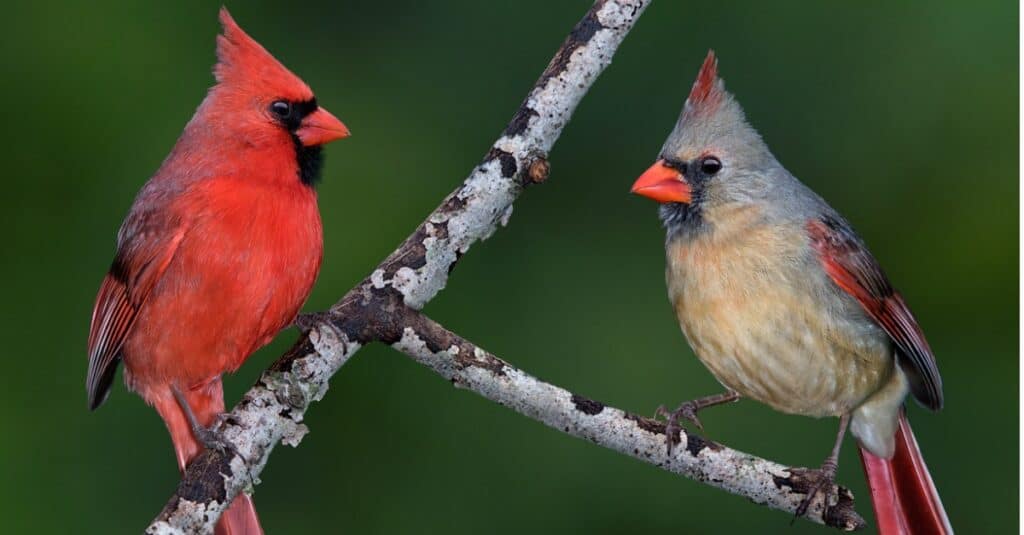
©Cathy Keifer/Shutterstock.com
According to the known facts about the bird, the northern cardinal is not endangered or threatened, but it can encounter many outdoor hazards. The IUCN Red List states its population is stable and listed as Least Concern.
View all 65 animals that start with NNorthern Cardinal FAQs (Frequently Asked Questions)
What does it mean when you see a Northern cardinal?
Seeing any red cardinal symbolizes a ray of hope and represents good luck and new beginnings.
What is the difference between a cardinal and a Northern cardinal?
The geographical range in which they are found.
Where do Northern Cardinals live?
North and South America.
What does a Northern cardinal sound like?
It has several calls: “cheer, cheer, cheer, what, what, what, what,” , “purdy, purdy, purdy…whoit, whoit, whoit, whoit”, “cheeeer-a-dote, cheeer-a-dote-dote-dote,” and “what-cheer, what-cheer… wheet, wheet, wheet, wheet.”
What do Northern cardinals eat?
Seeds, grains, insects and fruit.
Do Northern cardinals migrate?
No
How many eggs do Northern cardinals lay?
3-4
How fast do Northern cardinals fly?
19-37mph with an average of 25mph.
What is Northern cardinal's wingspan?
9.8-12.2 inches.
When do northern cardinals leave the nest?
10-11 days after hatching.
What are the differences between male and female northern cardinals?
Male and female northern cardinals have some differences in their size, appearance as well as behaviors.
Thank you for reading! Have some feedback for us? Contact the AZ Animals editorial team.
Sources
- Wikipedia / Accessed July 14, 2021
- BioExplorer / Accessed July 14, 2021
- What Birds are in My Back Yard? / Accessed July 14, 2021
- Animalia / Accessed July 15, 2021
- BirdWatching Buzz / Accessed July 15, 2021
- Country Captures / Accessed July 15, 2021
- Sciencing / Accessed July 15, 2021
- Answers / Accessed July 15, 2021
- Animal Diversity Web / Accessed July 15, 2021
- Caring Cardinals / Accessed July 15, 2021
- The Spruce / Accessed July 16, 2021
- Answers / Accessed July 16, 2021
- BirdWatching Buzz / Accessed July 16, 2021
- Texas A&M AgriLife Research (1970) https://txtbba.tamu.edu/species-accounts/northern-cardinal/ Jump to top / Accessed July 16, 2021


















